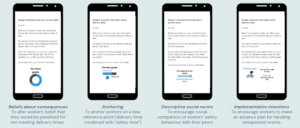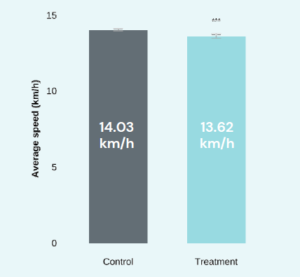In this time of COVID-19, we’ve seen the rise of a new hero: the food delivery worker (FDW). FDWs brave the streets and keep us well fed from our local restaurants as we move in and out of lockdowns.
But the work of an FDW can be dangerous, and until now, little research has been done to understand the risks faced by FDWs in the gig economy, or how to manage those risks. With increasing public and government interest in the issue, we partnered with the Centre for Work Health and Safety in New South Wales, Australia, and a major food delivery platform to better understand the work health and safety (WHS) issues faced by FDWs, and develop and test behaviourally-informed approaches to improve safety messaging and address these issues.

The road to greater safety for FDWs hasn’t been without its bumps. Safety messaging is critical for protecting workers against harm — and through this project, we found that behavioural techniques have the potential to make this messaging more effective. However, we discovered that the real challenge lies in FDW engagement — safety messaging does no good if no one reads the messages!
Before we could even start shaping safety messages, we had to understand the risks and behaviours of FDWs. We kicked things off by looking at the experiences of FDWs and the setup of food delivery platforms, through a series of interviews, surveys and a ‘service safari’ (in which members of the project team signed up to delivery platforms, went through onboarding, and worked a shift as an FDW).
Through this, we uncovered the main WHS concerns as seen by both FDWs and platform stakeholders, and the current actions both parties take to reduce risk — as well as the risk-taking behaviours they engage in, and why. For example, despite traffic accidents being the top WHS concern for FDWs and platforms alike, FDWs frequently do risky things such as speeding to make deliveries, or riding on footpaths and through red lights.
When we investigated why that might be, we discovered two things. Firstly, FDWs reported feeling constant pressure with their delivery timeframes. Secondly, when we undertook our service safari, our team noticed that the delivery time stated in the app was sometimes less than the estimated travel times. These unsafe behaviours, then, were partly stemming from a belief that app delivery times are deadlines, not estimates, with penalties if they’re missed.

Using this knowledge, we co-designed (with workers and platform stakeholders) an intervention: while we couldn’t make big structural changes to the platforms, we could work to change this misperception, and the consequent risk-taking behaviour. We designed a series of behaviourally-informed in-app messages to reframe workers’ perceptions of delivery times as estimations rather than expectations.
We tested the effectiveness of these messages through a randomised control trial with 14,281 workers across Sydney and Melbourne, with messages sent via a major delivery platform’s in-app messaging system. The effectiveness of the messaging was evaluated by measuring the average travel speeds per delivery — that is, we aimed to get FDWs to slow down. This is where we hit our bump in the road.

At first glance, it looked like the messages had no significant effect on average travel speeds. However, we anticipated that engagement may be low, so we dug a little deeper, and found that only a small number of FDWs had actually opened the messages — and when we looked only at those who had read at least one message, it appeared there was a modest but significant effect, with those workers travelling 3% slower than the control group.
While low engagement resulted in low impact, it is nonetheless a promising outcome: it shows that behaviourally-informed safety messaging has potential to mitigate WHS risks. Most importantly, though, it highlights that we have an even bigger challenge to tackle first: getting workers engaged.
So, what does this mean for future safety messaging? As we detail in our implementation guide, getting the timing and touchpoints for messages right is essential. We need to reach workers at critical moments (such as in response to specific environmental cues or actions) and through relevant channels. Working out when and how we send messages to maximise engagement is just as important as what we say in those messages.
With this guidance supporting a bigger piece of work by the Food Delivery Rider Taskforce, we hope the lessons learned here about safety messaging will help keep our food delivery workers safe on the road.
Want to know more about our work on safety messaging, or interested in testing what works for your organisation? Get in touch with Dr Elizabeth Convery.





